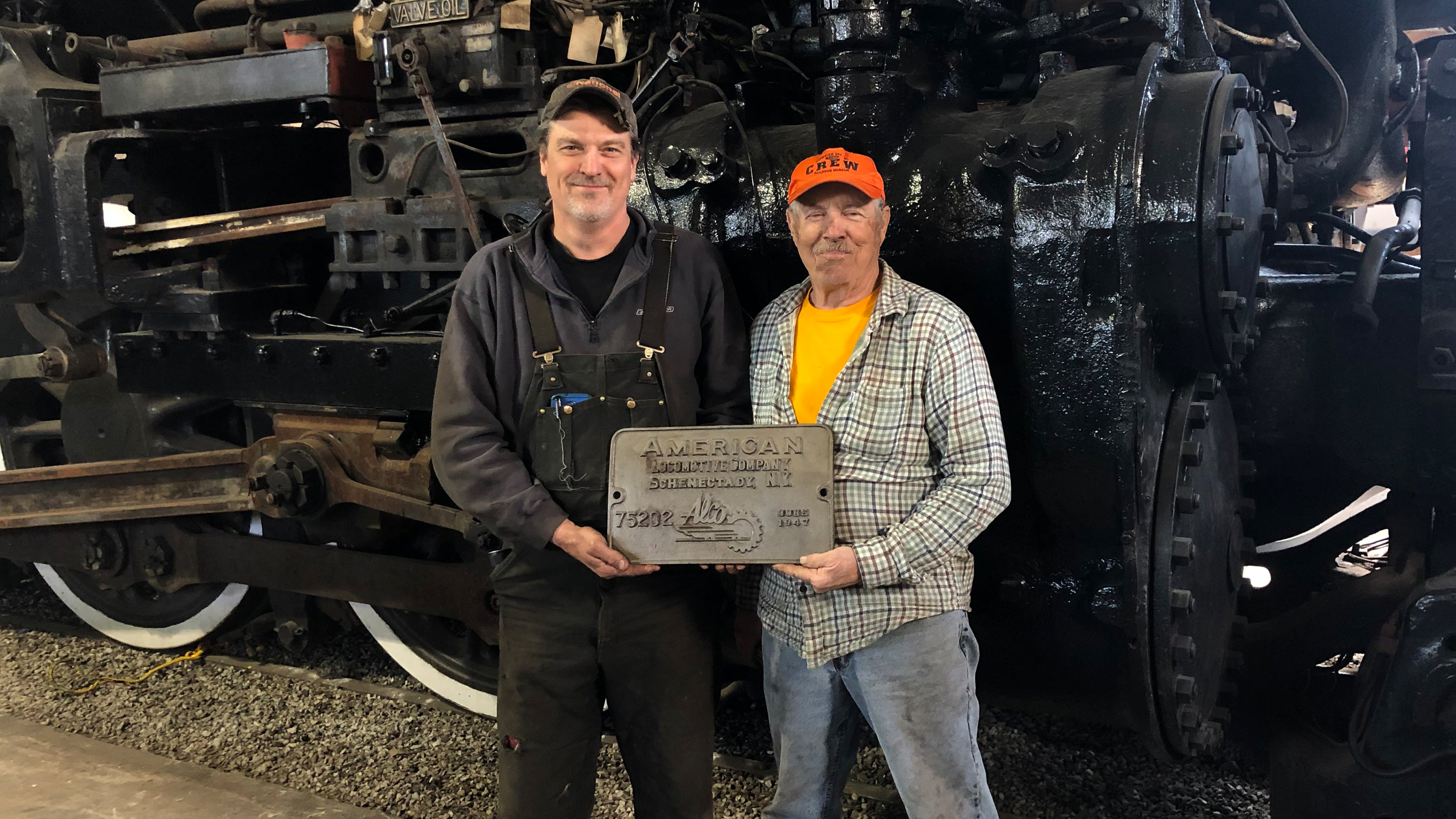The museum is open from 9:00 am to 4:00 pm CDT.
Hoosier Valley Railroad Museum Acquires a Small Piece of History

Current museum president Todd Flanigan (left) and former president John LaOrange (right) hold the builder’s plate of steam locomotive no. 2789. LaOrange was instrumental in bringing the locomotive to North Judson in 1988 and forming the organization. The Hoosier Valley Railroad Museum is beginning efforts to place the locomotive on the National Register of Historic Places.
Museum launches effort to place locomotive on the National Register of Historic Places
NORTH JUDSON, INDIANA – The Hoosier Valley Railroad Museum has acquired a piece of history with special significance. An original builder’s plate for Chesapeake & Ohio steam engine no. 2789 has been reunited with the locomotive. The locomotive is the crown jewel of the museum’s collection.
The cast iron plate contains the locomotive’s serial number and build date and can be likened to a VIN plate on your family’s car, only larger and much heavier. These plates are extremely sought-after by collectors and was probably removed from the locomotive by the railroad some time in the late 1950s. The locomotive was built by the American Locomotive Company in Schenectady, New York, in June 1947.
Museum secretary Kyle Flanigan did the legwork to acquire the builder’s plate. “Once these kinds of things are gone from a locomotive they are usually gone forever. To have an opportunity like this we simply could not let it slip away.” Flanigan went on to say, “We are extremely grateful to be able to reunite the plate with the 2789.”
While the locomotive itself is a unique piece of railroad history, the plate is equally as rare. The American Locomotive Company built more than 75,000 locomotives during its existence, but only 56 domestic locomotives carried this particular type of plate, which features the “Flying Alco” design. The design signified the transition from steam to diesel power.
The acquisition of the builder’s plate coincides with the museum’s effort to place steam locomotive no. 2789 on the National Register of Historic Places. Kurt W. Garner of Plymouth, Indiana, has been selected to work on the submission process. Garner previously worked with the museum to develop its master plan.
Garner went on to say, “It has added significance as one of the network of Friendship Trains and the listing will open opportunities for restoration grants.” The locomotive took park in the Southwest Friendship Train in 1947, an effort to send food and supplies to Europe at the close of World War II.
Additionally, locomotive no. 2789 is unique in that it was the last in a series of 90 Kanawha-type steam engines built for the Chesapeake & Ohio Railway and the only surviving example to be constructed with a welded boiler. The welded boiler was a feat of engineering during the era in which it was constructed and only five such examples were built for the C&O.
About the Museum
Founded in 1988, the Hoosier Valley Railroad Museum is a 501(c)(3) non-profit educational organization dedicated to the preservation of railroad history in northwest Indiana. The museum educates the public through interpretive displays and its tourist railroad that operates over several miles of former Chesapeake & Ohio track saved from abandonment in 2004.
Additional information about the museum can be found online at hoosiervalley.org or on the museum’s Facebook page at @hoosiervalley.

An original builder's plate for C&O no. 2789 is shown above. The plate was acquired by the museum and reunited with the locomotive. It shows Alco serial no. 75202 and the build date of June 1947.
Correction
The above news release incorrectly stated that the submission to the National Register would be the first rail-related one in Indiana. The Fort Wayne Railroad Historical Society's Nickel Plate Road 765 was submitted to the National Register in 1996. We apologize for the error.
Hoosier Valley Railroad Museum
P.O. Box 75
North Judson, Indiana 46366
Call or Email
574-896-3950 Depot Phone
[email protected]

